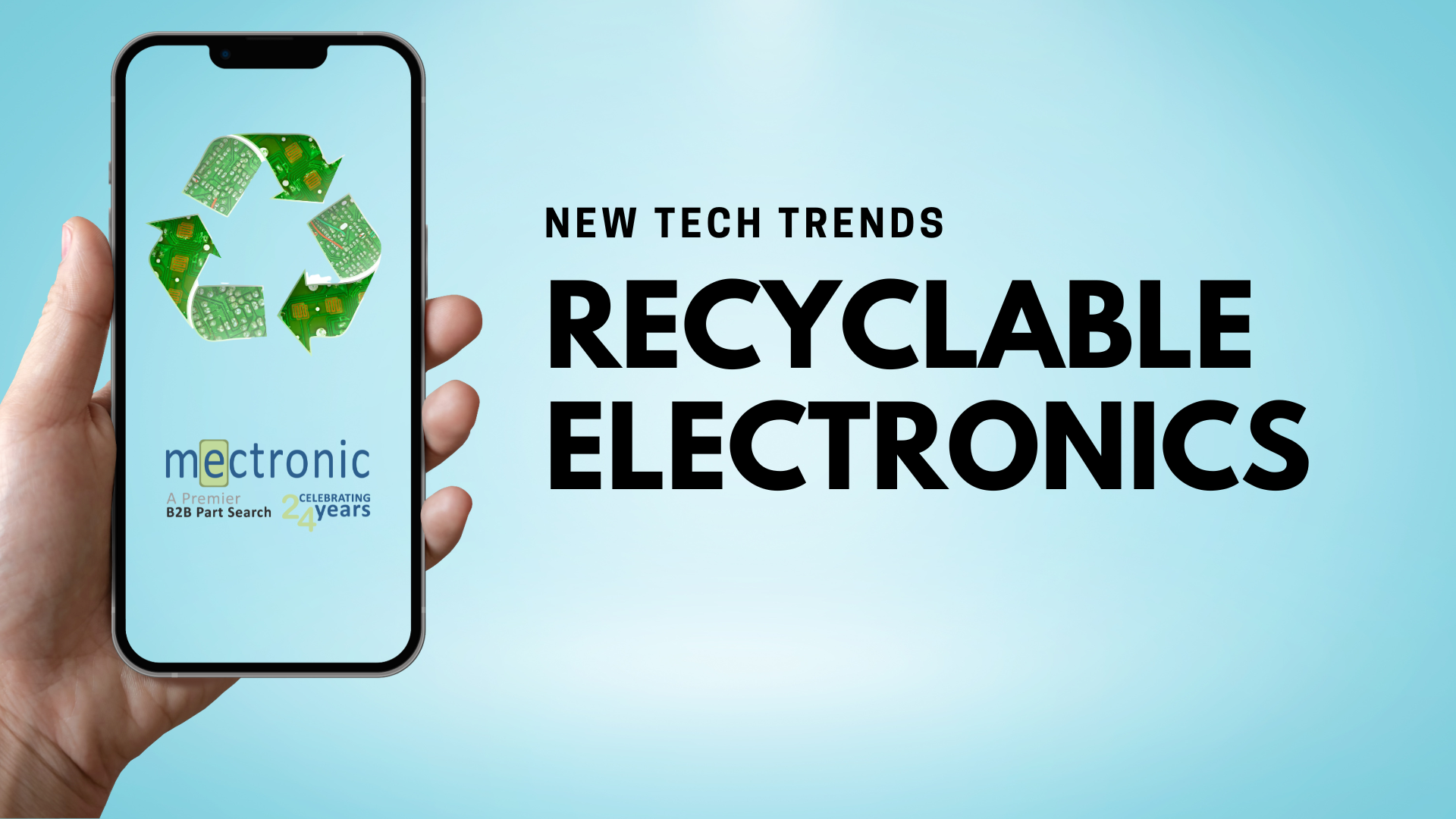Scientists approach most research and development with an end goal in mind. Leaders in the emerging field of recyclable electronics take a unique approach with the end goal of projects relating to the end-life of resulting products. As e-waste continues to pile up with alarming speed worldwide, new recyclable tech innovations offer hope.
E-waste collectively describes all the various electronics consumers throw away in pursuit of the newest gadgets on the market. This accumulation includes old cell phones, laptops, tablets, and other assorted electronics left piling up in landfills around the globe.
Measuring E-waste can be challenging, but estimates suggest the world generates roughly 50 million tons of electronic waste each year. To provide context, 50 million tons of electronic waste is equivalent to throwing away 1000 laptops every second.
Haunting Impacts of E-Waste
E-waste is quickly becoming a serious environmental issue. Improper disposal of electronic components and devices results in environmental damage and destruction far beyond the unsettling sight made by mountainous piles of old cell phones left to rot slowly in landfills worldwide.

Electronic waste left exposed to the elements releases toxic substances such as lead, cadmium, and mercury into the surrounding soil and watersheds. Once these toxic substances leak into the soil and reach local watersheds, they travel to connected water sources, such as streams, lakes, and rivers. This movement through the watershed exposes plants and animals to toxins before eventually arriving at critical sources for human drinking water and recreation.
Additionally, improper disposal of electronics generates harmful air pollution and greenhouse gas emissions. Batteries and components can release gases such as carbon dioxide and methane. Burning of disposed-of electronics at landfills also releases several chemicals known to irritate the human respiratory system.
Compounding harms caused by e-waste, the energy and resources manufacturers devote to meeting consumers’ growing appetite for new electronics create additional challenges. By recycling electronic waste, we can conserve natural resources, reduce pollution, and mitigate the harmful that effects old electronics ravage the environment.
What Are Recyclable Electronics?
‘Recyclable electronics’ describes a subset of electronics and electrical components to minimize waste. These electronic devices are engineered for easy disassembly and constructed from recyclable materials.
Early sustainability efforts focused on recycling metal components within electronics and components. In fact, recycling processes have long existed for melting down and reusing metal. Throughout the last several decades, scientists refined these processes to minimize hazardous byproducts and increase efficiency.
Advances in materials science deliver the functionality and reliability consumers expect from modern electronic products. These advances also ensure that more of each product can be safely reused or recycled. Modern efforts also work to improve industrial processes and efficiencies, with manufacturers designing electronics more readily disassembled into recyclable components.
More than Metals: Material Science Behind Recyclable Electronics
In addition to more efficient metal recycling processes, researchers develop new materials that promise to minimize e-waste and promote sustainability.
Some researchers look towards more biodegradable materials to turn the rising tide of e-waste from electronics.
Novel projects that incorporate unusual materials offer new approaches to the e-waste issue. A team of University of Wisconsin-Madison researchers developed innovative thin-film transistors made from a biodegradable wood-based product called cellulose nanofibrillated fiber (CNF).

Corn starch also offers hope for more fully biodegradable electronics and components. A team of Chinese researchers developed a bioplastic derived from corn starch that blends metal-organic framework nanoparticles with polylactic acid to create a promising new material for electronic substrate or insulator components. This new material features the mechanical, electrical, and flame-retardant characteristics necessary for use in electronics.
Growing Emphasis On Sustainability Drives Product Design With Recycling Focus
Several new technologies promote sustainability and empower manufacturers to embrace recyclable electronics. These technologies address e-waste by increasing emphasis on using more recycled materials during the manufacturing process, as well as designing new electronics with the end goal of easier recycling in mind.
Examples of these new technologies include:
- Modular Component Design: Modular design in electronics and electronic component manufacturing sources separate, interchangeable components for easier replacement and upgrades. This process promotes the repairing and recycling of devices while reducing the amount of electronic waste generated.
- Design for disassembly: Some manufacturers create products that can be taken apart easily without causing damage to the components or materials. Technologies that facilitate design for disassembly make it easier and more profitable to recycle different product parts and reduce waste.
- Sustainable materials: Researchers are exploring sustainable and biodegradable materials for electronics manufacturing. Some manufacturers substitute plant-based plastics and biodegradable materials in place of traditional plastics and metals.
- Closed-loop recycling: Closed-loop recycling sources materials from old electronics to produce new electronics. Reducing the need for virgin materials helps create a circular economy for electronics.
Many Major Manufacturers Invest in Recyclable Technology
Many electronics manufacturers strive to create more recyclable products and reduce e-waste. Below are just a few of the many brands and manufacturers making real strides toward e-waste reduction and increased sustainability in the electronics industry.
Panasonic partnered with ERI to advance circularity within its U.S. supply chain, where components from its consumer electronics, starting with personal care devices, are recycled by ERI. Lithium-ion batteries in Panasonic shavers devices are sent to Redwood Materials. The facility recycles shavers to remanufacture metals into anodes and cathodes for Panasonic’s electric vehicle (EV) batteries.
Texas Instruments introduced the “Environmental Management System,” focusing on reducing the environmental impact of their products. They aim to reduce waste and energy consumption in their manufacturing processes while increasing reliance on recyclable materials across their production facilities.
The new MacBook Air features recycled aluminum and other environmentally sustainable materials. The laptop’s modular design supports easier repair and component replacement. Apple also recently implemented a take-back program, allowing customers to recycle their old devices free of charge.
These are just a few of the many manufacturers and brands dedicated to increasing sustainability throughout the electronics industry. When combined with existing programs to increase consumer recycling of old electronics, the electronics industry is poised to significantly reduce the harmful impacts of e-waste.
Interested in the latest trends and innovations in technology? The Mectronic blog is your source for trusted insight into the technology world. Check our blog for regular updates!

Mectronic has been connecting sellers and buyers for 25 years. With powerful search tools and over 2 billion products, Mectronic helps you find the B2B components you need from sources you trust. Find the parts and components you need today here!





